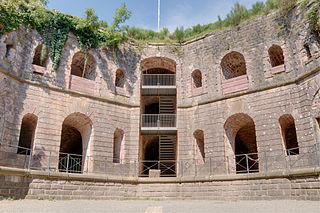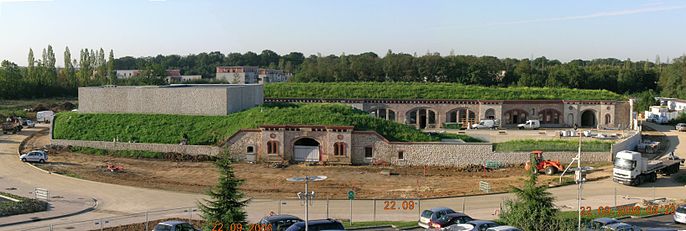
The Fort de Tournoux is a fortification complex in the Ubaye Valley in the French Alps. It was built between 1843 and the early 20th century to defend France against invasion from Italy and Savoy. It was described as the "Military Versailles of the 19th century," resembling a Tibetan monastery on the mountainside above the Ubaye. The fort is actually an ensemble of fortifications, including some "batteries" that rival the main fort in size and power.

Ouvrage Sapey is a work of the Maginot Line's Alpine extension, the Alpine Line, also known as the Little Maginot Line. The ouvrage consists of one entry block, three artillery blocks and one observation block two kilometers west of Modane. The ouvrage was built beneath the older Fort du Sapey. The new work cost 12.8 million francs.

Ouvrage Roche-la-Croix is a work of the Maginot Line's Alpine extension, the Alpine Line, also known as the Little Maginot Line. The ouvrage consists of one entry block, two infantry blocks, one artillery block and two observation blocks in the vicinity of the Col de Larche. An aerial tram was provided for better access. The position is located at the top of a sheer escarpment that dominates Meyronnes and the valley of the Ubayette.
Ouvrage Barbonnet is a work of the Maginot Line's Alpine extension, the Alpine Line, also called the Little Maginot Line. The ouvrage consists of one entry block and one infantry block facing Italy. The ouvrage was built somewhat behind the main line of fortifications on the old Fort Suchet, which was already armed with two obsolete Mougin 155 mm gun turrets.

The Séré de Rivières system was an ensemble of fortifications built from 1874 along the frontiers, ridges and coasts of France. The fortifications were named after their architect, Brigadier-General Raymond Adolphe Séré de Rivières. The fortresses were obsolescent by 1914 but were used during the First World War.

Fort de Vézelois, also known as Fort Ordener, was built between 1883 and 1886 near Vézelois, to the southeast of Belfort in northeastern France. It is part of the first ring of fortifications around the city of Belfort. It is part of the second ring of fortifications around the city of Belfort in northeastern France. This set of forts was built as part of the Séré de Rivières system and incorporated improvements to deal with the improvement in efficacy of artillery in the late 19th century. The fort was formally named after French General Michel Ordener.

Fort de Giromagny, also known as Fort Dorsner, was built near Belfort in northeastern France between 1875 and 1879. The fort forms the southern end of the defensive curtain of the Haute Moselle Region, abutting the fortified region of Belfort, which lies to its south. The Haute Moselle defenses form a link between the fortified encampments of Épinal and Belfort. The fort overlooks the main roads to the northeast of Belfort, which form a crossroads at Giromagny.

The Fort de Saint-Cyr, located in the commune of Montigny-le-Bretonneux, (Yvelines), is one of the forts built at the end of the 19th century to defend Paris. After the first world war the fort was used as an army weather station and arms depot. Classed in 1992 as a monument historique, it is now used as a film depository for the preservation of movies under the Cinémathèque française.

Fort de Villey-le-Sec, also known as Fort Trévise, is a fortification of the 19th century, built as part of the Séré de Rivières system of fortifications in Villey-le-Sec, France, one of the defenses of Toul. It is a unique example for its time of a defensive enclosure around a village. Conceived after the defeat of the Franco-Prussian War of 1870-71, the fort was located away from the main combat zone of World War I and has remained almost intact. The fort's preservation association has been at work since 1961 to restore and interpret the site. It has been included in the Inventory of Historic Sites and has been designated as a preserved natural area.

The Fort de Vaujours, located in the commune of Courtry, Seine-Saint-Denis, near the town of Vaujours, is one of the forts built at the end of the 19th century to defend Paris. It became a research center for the Commissariat à l'énergie atomique (CEA), France's Atomic Energy Commission. The center was closed in 1997.

Fort du Mont Bart is located to the south of Montbéliard, France. It was built between November 1874 and July 1877 as part of the Séré de Rivières system of fortifications. The fort overlooks the valleys of the Doubs and the Allan at an elevation of 497 metres (1,631 ft), standing to the south and rear of the fortified region of Belfort and in control of the road to Besançon. The fort was intended to augment the Belfort fortifications and to prevent an enemy from bypassing them. The most striking feature of the Fort du Mont Bart is its "interior street", originally constructed in the open air as a sunken court, then covered before World War I with reinforced concrete.

The Fort de Châtillon was a fortification located about 5 kilometres (3.1 mi) south of Paris in the communes of Châtillon-sous-Bagneux and Fontenay-aux-Roses. It was built in 1874 and was razed beginning in 1957, making way for expansion of the French nuclear research facility at Fontenay-aux-Roses.

The Fort de Leveau, also known as Fort Schouller, is located in the commune of Feignies, France. It is part of the fortifications of Maubeuge, located to the northwest of the city, overlooking the railroad to Mons. The Séré de Rivières system fort was built 1882–1884, one of six forts built at the time. It is maintained as a museum by the town of Feignies.

The Fort de Maulde, also known as Fort de Beurnonville and the Ensemble de Maulde, is located to the south of Maulde, France. It is part of the Fortified Sector of the Escaut, an extension of the Maginot Line. The Séré de Rivières system fort was built 1881–1884. In 1936–1937 the old fort, commanding high ground behind Maulde, was altered for more modern fortifications. It was evacuated by its garrison in 1940 during the Battle of France as part of the French retreat from the border with Belgium.

The Fortified Sector of the Dauphiné was the French military organization that in 1940 controlled the section of the Alpine Line portion of the Maginot Line facing Italy in the vicinity of Briançon. By comparison with the integrated defenses of the main Maginot Line, or even of the Fortified Sector of the Maritime Alps to the south, the Dauphiné sector consisted of a series of distinct territories that covered two main invasion routes into France: the route from Turin over the Col de Montgenèvre to Briançon and Grenoble, and the route from Coni over the Col de Larche to Barcelonette and Gap. The sector was the scene of probing attacks by Italian forces during the Italian invasion of France in 1940, in which the French defenses successfully resisted Italian advances until the June 1940 armistice that granted Italy access to southeastern France.

The Fort des Ayvelles, also known as the Fort Dubois-Crancé, is a fortification near the French communes of Villers-Semeuse and Les Ayvelles in the Ardennes, just to the south of Charleville-Mézières. As part of the Séré de Rivières system of fortifications, the fort was planned as part of a new ring of forts replacing the older citadel of Mézières with dispersed fortifications. With advances in the range and destructive power of artillery, the city's defensive perimeter had to be pushed away from the city center to the limits of artillery range. The Fort des Ayvelles was the only such fortification to be completed of the ensemble, as resources were diverted elsewhere. At the time of its construction the fort controlled the Meuse and the railway line linking Reims, Montmédy, Givet and Hirson. The Fort des Ayvelles was reduced in status in 1899, its masonry construction rendered obsolete by the advent of high-explosive artillery shells. However, it was re-manned for the First World War before it was captured by the Germans on 29 August 1914. The fort was partly destroyed in 1918. During the Battle of France in 1940 the fort was bombarded. French resisters were executed at Ayvelles during both world wars. At present the fort is maintained by a preservation society, and may be visited.

The Fort de Bourlémont, or Fort Choiseul, was built between 1878 and 1881. The fort was built as part of the Séré de Rivières system of fortifications, which were conceived in response to the increasing power and range of artillery. The Fort de Bourlémont was part of the defenses of the Charmes Gap, in the town of Mont-lès-Neufchâteau, 3 kilometres (1.9 mi) west of Neufchâteau.

The Fort du Trou-d'Enfer, also known as the Réduit du Trou-d'Enfer, is one of the fortifications of Paris, It is located in Marly-le-Roi, in the departement of Yvelines. The fort was built between 1878 and 1881 for a garrison of 800 men. It was termed a réduit for its position surrounded by several smaller batteries. The fort was occupied by the Germans during World War II, who blew up their ammunition when they evacuated the fort in August 1944, damaging the fort. The fort is named for the farm on whose land it sits, the ferme du trou-d'enfer, literally "Hellhole Farm."

The Fort de Cormeilles-en-Parisis was constructed between 1874 and 1877 as part of a new plan for the defense of Paris developed by General Raymond Adolphe Séré de Rivières, near the town of Cormeilles-en-Parisis. During the Franco-Prussian War, German troops had used the hill upon which the fort sits as a spotting and firing location, ideal for the siting of new rifled guns whose range was increased over old-fashioned smooth-bore guns. These weapons could attack Paris from Cormeilles, so a new outer ring of forts had to be built outside the first ring of forts built in 1840–1860 to deny the area to enemy gunners. The Séré de Rivières system was designed as a response to these technological innovations, and to the loss of French territories in Alsace and Lorraine.
The forts of Metz are two fortified belts around the city of Metz in Lorraine. Built according to the design and theory of Raymond Adolphe Séré de Rivières at the end of the Second Empire—and later Hans von Biehler while Metz was under German control—they earned the city the reputation of premier stronghold of the German reich. These fortifications were particularly thorough given the city's strategic position between France and Germany. The detached forts and fortified groups of the Metz area were spared in World War I, but showed their full defensive potential in the Battle of Metz at the end of World War II.
































